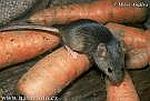House Mouse
Mus musculus
 |
|
The house mouse (Mus musculus) is one of the most troublesome and economically important rodents in the United States. House mice thrive under a variety of conditions; they are found in and around homes and commercial structures as well as in open fields and agricultural lands. House mice consume and contaminate food meant for humans, pets, livestock, or other animals. In addition, they cause considerable damage to structures and property, and they can transmit pathogens that cause diseases such as salmonellosis, a form of food poisoning. IDENTIFICATION House mice are small rodents with relatively large ears and small black eyes. They weigh about 1/2 ounce and usually are light brownish to gray in color. An adult is about 5 to 7 inches long, including the 3- to 4-inch tail.
Habits
Although house mice usually prefer to eat cereal grains, they are \"nibblers\" and will sample many different foods. Mice have keen senses of taste, hearing, smell, and touch. They are excellent climbers and can run up any rough vertical surface. They will run horizontally along wire cables or ropes and can jump up to 12 inches from the floor onto a flat surface. Mice can squeeze through openings slightly larger than 1/4 inch across. House mice frequently find their way into homes in the fall of the year, when outdoor temperatures at night become colder. In a single year, a female may have 5 to 10 litters of about 5 or 6 young. Young are born 19 to 21 days after mating, and they reach reproductive maturity in 6 to 10 weeks. The life span of a mouse is probably 9 to 12 months.
Habitat
Droppings, fresh gnaw marks, and tracks indicate areas where mice are active. Mouse nests are made from fine shredded paper or other fibrous material, usually in sheltered locations. House mice have a characteristic musky odor that identifies their presence. Mice are active mostly at night, but they can be seen occasionally during daylight hours
Threats
While the house mouse has not been found to be a carrier of hantavirus, other mice have. Most notable are the deer mouse and the white-footed mouse, which sometimes invade cabins and outbuildings in California. The house mouse is distinguished from the deer mouse and the white-footed mouse by its overall gray-colored coat. The other two species have a white underside with a distinct line of demarcation between the dark coloration on top and the white underside. In addition, the tail on the house mouse has almost no fur on it, whereas the tails of the deer mouse and the white-footed mouse are moderately to well furred and are light underneath and dark on top.
Prevention:
A key to successful long-term mouse control is the limitation of shelter and of food sources wherever possible. Trapping works well when mice are not numerous, or it can be used as a follow-up measure after a baiting program. When considering a baiting program, decide if the presence of dead mice will cause an odor or sanitation problem. If so, trapping may be the best approach. Removal of mice should be followed by taking steps to exclude them so that the problem does not recur.


